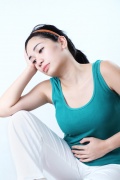Dysmenorrhea
Dysmenorrhea is the name given to painful menstrual periods and can be categorized as primary or secondary depending on the cause. Primary dysmenorrhea means the pain is not associated with a specific problem with the uterus or other pelvic organs. Increased activity of the hormone prostaglandin is thought to contribute. Secondary dysmenorrhea is caused by specific pelvic or systemic conditions including endometriosis, pelvic inflammatory disease, adhesions, ovarian cysts, celiac disease, adhesions, thyroid conditions, congenital malformations, narrowing of the cervical opening, polyps, or uterine fibroids.[1]
|
Dysmenorrhea | |
| Causes | Dietary Factors, Smoking, Stress |
|---|---|
| See Also | Women's Health, Uterine Fibroids, Ovarian Cysts |
| Books | Books on Women's Health |
| Articles | Articles on Women's Health |
Contents
Naturopathic Assessment
Causal Factors
In order to stimulate the innate ability of the body to heal the causes of disease must be identified and addressed. With dysmenorrhea, the causes are variable and include lifestyle and environmental factors. A detailed assessment is required to determine which factors are contributing to dysmenorrhea.
Lifestyle
- There are many dietary factors that seem to be correlated with dysmenorrhea including food allergies, food intolerances, adverse reactions to food, nutrient deficiencies, dietary imbalances.
- Decreased consumption of fruits and vegetables is associated with increased risk of dysmenorrhea.[2]
- Irregular eating patterns and diets high in processed food can intensify dysmenorrhea.
- Increased consumption of alcohol, caffeine, sugar and simple carbohydrates are associated with increased symptoms.
- Regular exercise can help prevent dysmenorrhea or at least alleviate the intensity of the symptoms.
- Inadequate sleep increases the likelihood of dysmenorrhea.
Social
- Emotional and physical stress seems to worsen dysmenorrhea.
- Dysmenorrhea tends to be worse in those individuals that suffer from stress and depression.[2]
Environmental
- environmental toxins often disrupt hormone levels and can contribute to dysmenorrhea.
External
- There appears to be a decreased risk of dysmenorrhea in those that smoke.[3]
- The mechanism for decreased incidence of dysmenorrhea in female cigarette smokers may lie in the possible inhibition of algesic prostaglandins smoking induced stimulation of beta-endorphin, nicotine, or acrolein.
Physiology
- Chronic constipation may be a contributing factor to dysmenorrhea.
- Shallow breathing and other breathing disorders are correlated with increased pain during menstruation.
Diagnostic Testing
Dysmenorrhea is diagnosed based on a females symptoms during menstruation. Diagnostic testing is not required, yet if the pain is intense or chronic, blood tests and imaging tests may be required to rule out other pathologies.
Related Symptoms and Conditions
Other conditions that may be associated with dysmenorrhea include:
Characteristics
Dysmenorrhea refers to pain at the time of menstruation. It can occur before, during, or after menstruation. The pain can be experienced as cramping, stabbing, twisting, distending or achy.
Naturopathic Treatment
The goal of naturopathic treatment is to support and work in tandem with the healing power of the body and to address the causal factors of disease with individual treatment strategies. Dysmenorrhea can typically be managed effectively with naturopathic treatments.
It is always advisable to work with a naturopathic doctor before engaging in any treatment plan.
Home Care
Home Care strategies include:
- Apply a heating pad or hot water bottle to the abdomen
- Apply pressure to the abdomen
- Take a warm bath
- Determine the position you are most comfortable in
- Do deep breathing exercises
Lifestyle
Lifestyle recommendations include:
- Eliminate all adverse food reactions including food allergies and food intolerances.
- Eliminate alcohol, caffeine, sugar and chocolate.[4]
- Choose whole unprocessed food such as whole grains, legumes, vegetables, nuts and seeds
- Ensure you drink adequate water.
- Ensure adequate sleep
Naturopathic Therapies
Naturopathic Therapies for dysmenorrhea include:
- Clinical Nutritional Supplementation includes
- Vitamins such as Vitamin B1, Vitamin B3, Vitamin B6, Vitamin C, Vitamin E
- Minerals such as calcium, magnesium
- Other supplements such as Omega-3 Fatty Acids, Evening primrose oil, [Melatonin]].
- Botanical remedies such as Black Cohosh (Cimicifuga racemosa),Chaste Tree (Vitex agnus-castus), Dong Quai (Angelica sinensis), Wild Yam (Dioscorea villosa),[5], [6] Turmeric (Curcuma longa), Motherwort (Leonurus cardiaca), Oregano (Origanum vulgare), Peppermint (Mentha piperita), Raspberry Leaf (Rubus idaeus)
- Homeopathic remedies such as Belladonna, Chamomilla, Cimicifuga, Cocculus, Colocynthis, Nux vomica.[7], [8] Cuprum, Gelsemium, Sabina
- Acupuncture can be helpful in both the prevention and treatment of dysmenorrhea.
References
Reviewed by Iva Lloyd, BScH, RPE, ND [1]
- ↑ Hudson T (2007) Women's Encyclopedia of Natural Medicine: Alternative Therapies and Integrative Medicine for Total Health. McGraw-Hill.
- ↑ 2.0 2.1 Tavallaee M, Joffres MR, Corber SJ, Bayanzadeh M, Rad MM (May 2011) The prevalence of menstrual pain and associated risk factors among Iranian women. J Obstet Gynaecol Res;37(5):442-51. PMID: 21208343.
- ↑ Backon J (Mar 1989) Negative correlation of cigarette smoking and dysmenorrhea: reduced prostaglandin synthesis due to beta-endorphin, nicotine, or acrolein antagonism. Med Hypotheses;28(3):213-4. PMID: 2523509.
- ↑ 4.0 4.1 Pizzorno Joseph, Murray Michael, Joiner-Bey Herb (2008) The Clinician's Handbook of Natural Medicine Churchill Livingstone Elsevier.
- ↑ Godfrey Anthony, Saunders Paul Richard, Barlow Kerry, Gilbert Cyndi, Gowan Matthew, Smith Fraser 2010 Principles and Practices of Naturopathic Botanical Medicine, Vol 1: Botanical Medicine Monographs, CCNM Press, Toronto
- ↑ Boon Heather, Smith Michael 2004 The Complete Natural Medicine Guide to the 50 Most Common Medicinal Herbs, Robert Rose, Toronto
- ↑ Hershoff Asa 2000 Homeopathic Remedies, A Quick and Easy Guide to Common Disorders and their Homeopathic Treatments, Avery Publishing Group, New York
- ↑ Ullman Robert, Reichenberg-Ullman Judyth 1997, Homeopathic Self-Care, the quick and easy guide for the whole family. Prima Publishing
